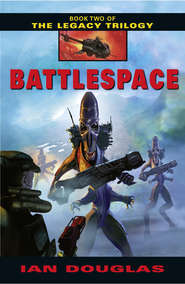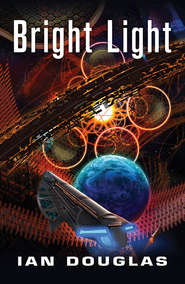По всем вопросам обращайтесь на: info@litportal.ru
(©) 2003-2024.
✖
The Star Carrier Series Books 1-3: Earth Strike, Centre of Gravity, Singularity
Настройки чтения
Размер шрифта
Высота строк
Поля
And suddenly things were very much more serious indeed.
Chapter Nineteen
18 October 2404
USNA Gallagher
Neptune Space, Sol System
0250 hours, TFT
The IP had come up empty.
The five High Guard vessels had rendezvoused in a high-velocity pass-through, but there’d been nothing there within range of their scanners. Captain Lederer had ordered the release of a dozen battlespace drones, set to disperse through local space and transmit anything they detected both to the Gallagher and to the Inner System. However, the good news for the moment was that the Turusch fleet was not in a hurry to reach Earth.
A careful scan of ambient space for the ionization trails left by near-c impactors or high-V fighters turned up nothing as well. Local space was thin—no more than a hydrogen atom or two per cubic centimeter, but the passage of anything traveling at a generous percentage of the speed of light swept up some of those atoms and ionized others, leaving a faint but detectable trail. The lack of such trails suggested that the enemy had not started bombarding the Inner System.
All very good news.
But that left the question of just where they were and what they were doing. That they would eventually head in-system was patently obvious. If they waited too long, the tactical advantage would pass to the Confederation.
So where in this hell of frozen emptiness were they?
Following the op plan drawn up by Gallagher’s navigational team, Lederer had ordered the tiny flotilla to apply side thrust, slightly changing their vector, until they were on a course taking them directly into the Neptune system. Neptune was ahead of the High Guard flotilla in its orbit and, at the moment, its moon Triton was located on the far side of the planet from the approaching ships. The alignment offered Lederer and the other High Guard captains a unique tactical advantage.
If the enemy fleet had gathered at Triton, perhaps the High Guard squadron could sneak up on them, using giant Neptune as a screen.
Lederer leaned forward in his recliner, studying the three-dimensional tactical display of local space. The other four High Guard ships, another destroyer and three frigates, trailed along behind the Gallagher in line-ahead. Ahead, less than half an AU now, lay the planet Neptune, shown in the display as an actual image, a tiny sea-blue sphere, rather than as an icon.
He was searching for some sign of the enemy fleet.
There were several ways of spotting other ships at a distance. Radar and lidar, of course, assuming the target wasn’t cloaked in either a grav-field effect or adaptive surface nano that absorbed those wavelengths rather than reflecting them back. Fusion power plants gave off neutrinos—but most modern Confederation ships used quantum zero-point field emission plants now, and it was thought that Turusch ships were powered by vacuum energy as well. A ship under drive was projecting artificial gravitational singularities either ahead or astern, and those created ripples—gravity waves—in the fabric of space that could be detected at considerable distances.
Gravity waves were transmitted at the speed of light; they also vanished when a ship’s singularity projectors were switched off. And even when plowing ahead at full speed, gravity waves tended to fuzz out and vanish in the background static of normal matter. The local star, planets, even asteroidal debris or large starships could damp out the space/time ripples from a projected singularity within a distance of a few astronomical units.
The best and most unambiguous way of detecting an enemy fleet was by the intense burst of photons released as it dropped below light speed. Under Alcubierre Drive and similar FTL systems, a starship essentially had no velocity at all in relation to the folded-up pocket of space within which it traveled. When the drive field was switched off, the ship was dumped into normal space with only a small residual velocity; the ship had carried a tremendous potential energy, however, much of which bled off into the local space/time background as an intense and expanding ring of radiation.
So far, thirty-three such flashes had been detected out in the Kuiper Belt, ranging from forty-five AUs from Sol out to more than eighty. The incoming Turusch had scattered badly. They needed a rendezvous point, and Neptune, it seemed, was the nearest convenient large object. In the past hours, however, the enemy fleet had vanished … save for the clue offered by the sudden silence of the base on Triton. The enemy could be anywhere, with its drives shut down and its shields up, effectively invisible.
But with shields up, it was difficult to impossible to detect ships outside your own little pocket universe; with shields up you were as cut off from the universe outside as you were under Alcubierre Drive. It was possible, even likely, that the enemy fleet had their shields full up in order to mask their presence.
Twelve minutes to go.
After four hours at five hundred gravities, Gallagher was coming in toward Neptune’s horizon at 72,000 kilometers per second—nearly one quarter of the speed of light. Half an AU was fifteen minutes at that speed. He called up Gallagher’s ephemeris data, studying it.
Since icy little Pluto had been demoted from planet status in the early twenty-first century, Neptune had held the honor of being the solar system’s outer planetary sentinel. Pure chance that it had happened to be in the same part of the sky where the Turusch had emerged from their equivalent of Alcubierre Drive, of course; at thirty AUs from the sun, Neptune took 165 years to complete one solar orbit. Because the atmospheres of both Neptune and of its near-twin Uranus were slightly different from those of the larger gas giants, Jupiter and Saturn, so much farther in toward the sun’s warmth and light, the two were officially known as ice giants.
Neptune’s large moon Triton was just visible beyond the planet’s limb, not perfectly masked by the planet from this position, but close.
Current theory stated that Triton had started out as a trans-Neptunian Kuiper object … a dwarf planet like Pluto or Eris. Its retrograde orbit—unique for such a large moon—showed that it had been captured by Neptune in eons past, probably in the early days of the solar system, when Neptune’s orbit migrated outward from between Saturn and Uranus to its present position. Triton, in fact, was slightly larger than Pluto; the surface composition of the two—frozen nitrogen, water ice, and frozen carbon dioxide—was nearly identical. Its surface temperature hovered at just 38 degrees Celsius above absolute zero, a few degrees colder even than the mean temperature on Pluto.
“We’re coming up on the final course correction, Skipper,” the Nav Officer told him, his voice edged with excitement. Lieutenant Raymond Seborg was a washout from Oceana, a would-be fighter-jock who’d ended up in the High Guard on the fast track to line command. The bridge crew still teased him about his predilection for handling a 220-meter-long destroyer like a Starhawk fighter.
“Very well, Mr. Seborg.” He opened his intercom link. “All hands, this is the captain. We’re about to drop into MGF. So far, there’s no sign that the enemy has seen us … or even that the enemy is here at all. Stay alert, and record everything that happens. When things start happening, they’re going to happen fast.”
MGF was the acronym for microgravitic flight … a fancy way of saying that the drive singularities would be shut down and the Gallagher would be falling solely under the influences of nearby planetary bodies, and its current velocity.
“Mr. Carlyle,” he added. “Shields to ninety percent, please.”
“Shields at nine-zero percent, aye, aye, sir.”
That would provide a reasonable level of protection, while allowing Gallagher’s sensors to continue to probe nearby space.
Astern, the other ships fell into the agreed-upon formation, a rough wedge with Gallagher at the leading point.
Getting the other four High Guard captains to follow his lead had been a real treat in and of itself. Balakrishnan on the Godavari was senior to Lederer by two years, and Zeng, of the Jianghua, had argued that the flotilla’s strategic decisions should be put to a vote. The High Guard, rather than maintaining a strict hierarchy of command, had been established as a free participation among the space-faring nations of Earth, under the direction of a multinational board of command. It worked well enough for organizing and sending out routine patrols, but was somewhat lacking when faced with a distinct military threat.
Lederer had bulled through by saying the others could follow his lead or get the hell out and return to the Inner System.
He’d broken all the rules of diplomacy, protocol, and international propriety, but they’d followed.
On the forward display, Neptune was rapidly growing larger, swelling from a blue dot lost among the stars to a half-phase, faintly banded giant. The small flotilla was falling toward Neptune’s south polar region; the planet was circled by fragmentary rings or ring arcs, which would make a high-velocity pass over the equatorial areas deadly.
The blue planet continued growing larger, and the distant red speck that was Triton dropped behind the horizon.
“Captain Lederer,” the ship’s AI said, “sensors are picking up numerous IR and radio wavelength anomalies within several million kilometers of Triton. The data are consistent with the presence of numerous large starships similar in configuration to those operated by the Turusch.”
“Thank you, Galley,” Lederer replied. The news was at once reassuring and frightening. It suggested that his guess had been right, that the alien fleet had closed in on Triton, then settled down to wait.
“Comm!” He added. “Are we transmitting?”
“Yes, sir. We’re sending it off as soon as we get it. Time lag to Earth, two hundred thirty-eight minutes. Time lag to Mars two hundred forty-five minutes.”
“Roger that.”
One minute to go. Neptune filled the forward screen, rushing out to block out half of the entire surrounding sky. Seborg’s last maneuver had nudged the Gallagher just enough to send the High Guard ship skimming within a thousand kilometers of Neptune’s cloud deck, close enough that they’d be burning through the tenuous outer layers of the huge planet’s atmosphere.
At a quarter of the speed of light, their passage through that tenuous atmosphere would be spectacular, but extremely brief.
It would also announce their arrival in rather definite terms, but the chances were good that the enemy had spotted them already. Even with their shields up, remote drones and sensors scattered throughout the area would be watching everything entering local space.
He wished there were a way for the little squadron to somehow strike at the enemy, but that was impossible. With no hard data on any targets near Triton, aiming would have been problematic. It was a moot point in any case. High Guard ships carried fusion bombs to nudge asteroids into new and non–Earth-threatening trajectories, but no ranged weapons. The destroyer’s missile launchers and particle-beam projectors all had been stripped out long ago to make more room for consumables on extended deep-space patrols.
There was a flash, then darkness as Gallagher’s shields went up full, together with a savage shock as the spacecraft tunneled through several thousand kilometers of hydrogen gas in a fraction of a second. They emerged on the far side, their trajectory slightly reshaped by Neptune’s gravity well.
They were now 350,000 kilometers from Triton—less than the distance from Earth to Earth’s moon. At their current velocity, they would cross that distance in slightly less than five seconds.
“Enemy ships!” Alys Newton, his scanner officer shouted. “I’ve got—”











